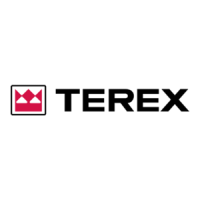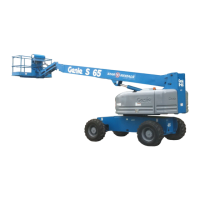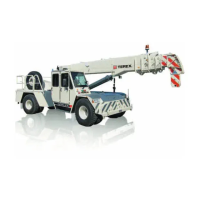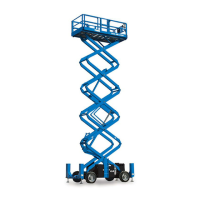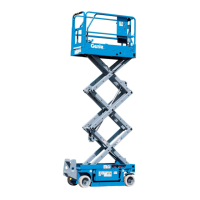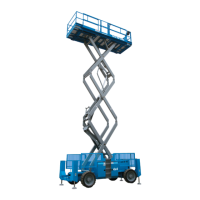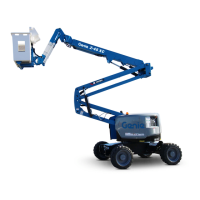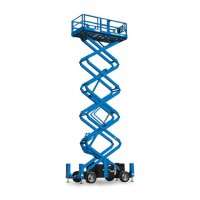Do you have a question about the Terex HP-32 and is the answer not in the manual?
Explains the purpose and scope of the manual for operation and maintenance.
Describes where to find the machine's serial number for identification.
Specifies the machine's designed purpose for bridge inspection and maintenance.
Discusses safety bulletins and compliance with product information.
Illustrates and labels safety signs on the machine for hazard awareness.
Details requirements for personal fall protection equipment (PFPE) when needed.
Explains dangers of contact with electrical power lines and required clearance.
Discusses risks and precautions related to machine tip-over, including outrigger deployment.
Details safe operation on inclines and super elevations, specifying limits.
Covers safety measures to prevent falls from the platform and guard rail use.
Outlines precautions to avoid collisions while operating and driving.
Warns about crushing hazards from moving parts, structures, and pinch points.
Warns about risks from leaks, moving parts, and accessing components.
Advises on preventing explosions and fires, especially around fuel and batteries.
Instructs on reporting and avoiding damaged or malfunctioning machines.
Covers safe practices for batteries, jump-starting, and welding.
Provides safety guidelines for handling batteries, including acid and electrical hazards.
Explains the importance and purpose of pre-operation checks before each work shift.
Lists items to check during a pre-operation inspection for machine condition.
Details the purpose of function tests to discover malfunctions before service.
Outlines procedures for testing machine functions like breakaway brake and parking brake.
Describes how to test the drive and steering functions for expected operation.
Guides on verifying decal legibility and placement on the machine.
Introduces the section and general operating principles for safe machine use.
Details steps for preparing the machine for operation in the work area.
Provides instructions for starting the engine, including cold conditions.
Explains how to use emergency power if the primary engine source fails.
Describes how to use the emergency stop button to halt all functions.
Covers operating the machine from the ground controls, including outriggers.
Details steps to erect the platform using base controls and remote pendant.
Explains how to use the intercom system for communication between operators.
Guides on positioning the platform with occupants during travel.
Instructions for driving and steering the machine safely.
Procedures for safely entering and exiting the platform.
Details the assembly, securing, and use of the elevated scaffold.
Covers operating from the elevated scaffold, emphasizing safety and communication.
Instructions for operating the machine from the main platform controls.
Procedures for securely attaching and towing the machine.
Explains how to operate and drive the machine on inclines and super elevations.
Provides detailed guidance on driving a vehicle that is pulling a trailer.
Instructions for checking and maintaining the engine oil level for optimal performance.
Guides on inspecting tires and wheels for wear, damage, and proper inflation.
Procedures for checking hydraulic oil level and identifying potential system problems.
Recommends regular inspection of tow vehicle and trailer brakes for safety.
Advises on ensuring the hitch remains secured to the tow vehicle and coupler to the trailer.
Instructions for checking and maintaining trailer wiring connections.
Emphasizes checking the breakaway brake system battery charge before towing.
Details on checking battery condition, connections, and hold-down brackets.
Outlines routine maintenance schedules and responsibilities for qualified technicians.
Explains the purpose and scope of the manual for operation and maintenance.
Describes where to find the machine's serial number for identification.
Specifies the machine's designed purpose for bridge inspection and maintenance.
Discusses safety bulletins and compliance with product information.
Illustrates and labels safety signs on the machine for hazard awareness.
Details requirements for personal fall protection equipment (PFPE) when needed.
Explains dangers of contact with electrical power lines and required clearance.
Discusses risks and precautions related to machine tip-over, including outrigger deployment.
Details safe operation on inclines and super elevations, specifying limits.
Covers safety measures to prevent falls from the platform and guard rail use.
Outlines precautions to avoid collisions while operating and driving.
Warns about crushing hazards from moving parts, structures, and pinch points.
Warns about risks from leaks, moving parts, and accessing components.
Advises on preventing explosions and fires, especially around fuel and batteries.
Instructs on reporting and avoiding damaged or malfunctioning machines.
Covers safe practices for batteries, jump-starting, and welding.
Provides safety guidelines for handling batteries, including acid and electrical hazards.
Explains the importance and purpose of pre-operation checks before each work shift.
Lists items to check during a pre-operation inspection for machine condition.
Details the purpose of function tests to discover malfunctions before service.
Outlines procedures for testing machine functions like breakaway brake and parking brake.
Describes how to test the drive and steering functions for expected operation.
Guides on verifying decal legibility and placement on the machine.
Introduces the section and general operating principles for safe machine use.
Details steps for preparing the machine for operation in the work area.
Provides instructions for starting the engine, including cold conditions.
Explains how to use emergency power if the primary engine source fails.
Describes how to use the emergency stop button to halt all functions.
Covers operating the machine from the ground controls, including outriggers.
Details steps to erect the platform using base controls and remote pendant.
Explains how to use the intercom system for communication between operators.
Guides on positioning the platform with occupants during travel.
Instructions for driving and steering the machine safely.
Procedures for safely entering and exiting the platform.
Details the assembly, securing, and use of the elevated scaffold.
Covers operating from the elevated scaffold, emphasizing safety and communication.
Instructions for operating the machine from the main platform controls.
Procedures for securely attaching and towing the machine.
Explains how to operate and drive the machine on inclines and super elevations.
Provides detailed guidance on driving a vehicle that is pulling a trailer.
Instructions for checking and maintaining the engine oil level for optimal performance.
Guides on inspecting tires and wheels for wear, damage, and proper inflation.
Procedures for checking hydraulic oil level and identifying potential system problems.
Recommends regular inspection of tow vehicle and trailer brakes for safety.
Advises on ensuring the hitch remains secured to the tow vehicle and coupler to the trailer.
Instructions for checking and maintaining trailer wiring connections.
Emphasizes checking the breakaway brake system battery charge before towing.
Details on checking battery condition, connections, and hold-down brackets.
Outlines routine maintenance schedules and responsibilities for qualified technicians.
| Brand | Terex |
|---|---|
| Model | HP-32 |
| Category | Lifting Systems |
| Language | English |
